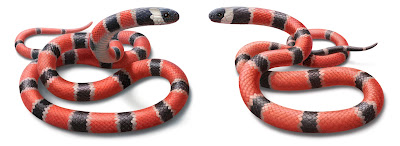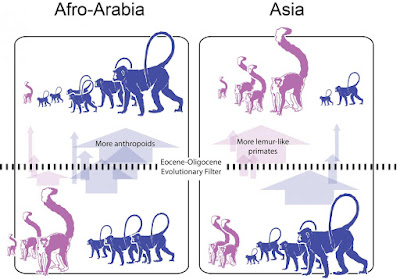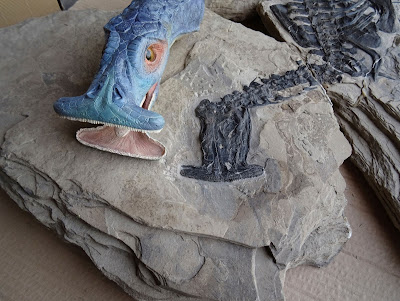[Most Recent Entries] [Calendar View]
Sunday, May 8th, 2016
| Time | Event | ||||
| 8:00a | [Herpetology • 2016] Coral Snakes predict the Evolution of Mimicry across New World Snakes
Abstract Batesian mimicry, in which harmless species (mimics) deter predators by deceitfully imitating the warning signals of noxious species (models), generates striking cases of phenotypic convergence that are classic examples of evolution by natural selection. However, mimicry of venomous coral snakes has remained controversial because of unresolved conflict between the predictions of mimicry theory and empirical patterns in the distribution and abundance of snakes. Here we integrate distributional, phenotypic and phylogenetic data across all New World snake species to demonstrate that shifts to mimetic coloration in nonvenomous snakes are highly correlated with coral snakes in both space and time, providing overwhelming support for Batesian mimicry. We also find that bidirectional transitions between mimetic and cryptic coloration are unexpectedly frequent over both long- and short-time scales, challenging traditional views of mimicry as a stable evolutionary ‘end point’ and suggesting that insect and snake mimicry may have different evolutionary dynamics.
Alison R. Davis Rabosky, Christian L. Cox, Daniel L. Rabosky, Pascal O. Title, Iris A. Holmes, Anat Feldman and Jimmy A. McGuire. 2016. Coral Snakes predict the Evolution of Mimicry across New World Snakes. Nature Communications. 7(11484). DOI: 10.1038/ncomms11484 Deadly snakes or just pretending? The evolution of mimicry http://phy.so/381734664 via @physorg_com | ||||
| 8:21a | [PaleoMammalogy • 2016] Oligocene Primates from China Reveal Divergence between African and Asian Primate Evolution Abstract Profound environmental and faunal changes are associated with climatic deterioration during the Eocene-Oligocene transition (EOT) roughly 34 million years ago. Reconstructing how Asian primates responded to the EOT has been hindered by a sparse record of Oligocene primates on that continent. Here, we report the discovery of a diverse primate fauna from the early Oligocene of southern China. In marked contrast to Afro-Arabian Oligocene primate faunas, this Asian fauna is dominated by strepsirhines. There appears to be a strong break between Paleogene and Neogene Asian anthropoid assemblages. Asian and Afro-Arabian primate faunas responded differently to EOT climatic deterioration, indicating that the EOT functioned as a critical evolutionary filter constraining the subsequent course of primate evolution across the Old World. Primates Linnaeus, 1758; Strepsirhini Geoffroy,1812; Adapiformes Hoffstetter, 1977; • Sivaladapidae Thomas and Verma, 1979; Yunnanadapis gen. nov. Type species: Yunnanadapis folivorus sp. nov. Included species: The type species and Yunnanadapis imperator sp. nov. Etymology: Generic name recognizes the geographic provenance of this taxon and its adapiform affinities. Laomaki yunnanensis gen. et sp. nov. Etymology: Generic name derives from the Mandarin“lao”(old) and the Malagasy“maky”(lemur). Trivial name reflects the geographic provenance of this species. • Ekgmowechashalidae Szalay, 1976; Gatanthropus micros gen. et sp. nov. Etymology: In allusionto the ekgmowechashalid affinities of this taxon,its generic name derives from the Greek“gata”(cat) and“anthropus”(man), and its trivial name derives from the Greek “micros”(small). Ekgmowechashala signifies“little cat man”in the Lakotalanguage, which lacks a term for non-human primates. Haplorhini Pocock, 1918; Tarsiiformes Gregory,1915; • Tarsiidae Gray, 1825; Oligotarsius rarus gen. et sp. nov. Etymology: Generic name reflects the age of this taxon. Trivial name reflects the sparse documentation of Tarsiidae in the fossil record generally, as well as the meager representation of this species in the Caijiachong early Oligocene fauna. Anthropoidea Mivart, 1864; • Eosimiidae Beard et al., 1994; Bahinia Jaeger et al., 1999; Bahinia banyueae sp. nov. Etymology: Trivial name honors the pioneering work on the Caijiachong mammal faunas of Yunnan Province made by our friend and colleague Banyue Wang. Xijun Ni, Qiang Li, Lüzhou Li and K. Christopher Beard. 2016. Oligocene Primates from China Reveal Divergence between African and Asian Primate Evolution. Science. 352(6286); 673-677. DOI: 10.1126/science.aaf2107 Could these new fossils solve 'paradox' of primate evolution? http://fw.to/ESIEKUg Six new fossil species form 'snapshot' of primates stressed by ancient climate change http://phy.so/381644194 via @physorg_com Climate filters dominant species The transition between the Eocene and Oligocene periods was marked by distinct cooling. Because primate species are particularly susceptible to cold, this change in climate drove a retraction of primates globally. After this transition, anthropoid primates were dominant in Afro-Arabian regions, but little has been known about primate reestablishment in Asia. Ni et al. describe 10 previously unknown primates found in Yunnan Province in China that show that primates took a different path in Asia. Instead of anthropoids, strepsirrhine (lemur-like) primates were dominant. It is still unknown whether this difference was due to the environment or chance. | ||||
| 4:45p | [Paleontology • 2016] Atopodentatus unicus • The Earliest Herbivorous Marine Reptile and Its Remarkable Jaw Apparatus
Abstract Newly discovered fossils of the Middle Triassic reptile Atopodentatus unicus call for a radical reassessment of its feeding behavior. The skull displays a pronounced hammerhead shape that was hitherto unknown. The long, straight anterior edges of both upper and lower jaws were lined with batteries of chisel-shaped teeth, whereas the remaining parts of the jaw rami supported densely packed needle-shaped teeth forming a mesh. The evidence indicates a novel feeding mechanism wherein the chisel-shaped teeth were used to scrape algae off the substrate, and the plant matter that was loosened was filtered from the water column through the more posteriorly positioned tooth mesh. This is the oldest record of herbivory within marine reptiles. Keywords: paleontology, marine reptiles, Atopodentatus unicus, Middle Triassic Fig. 3 Artist’s restoration of Atopodentatus unicus depicting it as a herbivore grazing on marine plants growing on a hard substrate in the eastern Tethyan Sea during Middle Triassic times. Using batteries of spatulate teeth lining the hammerhead expansions of both the upper and lower jaws, it would have been able to scrape off numerous pieces of plant matter into suspension in the water. This could then be sucked in and filtered by the long, thin, and closely packed needle-shaped teeth lining the main jaw rami. [Illustration: Y. Chen, Institute of Vertebrate Paleontology and Paleoanthropology] Li Chun, Olivier Rieppel, Cheng Long and Nicholas C. Fraser. 2016. The Earliest Herbivorous Marine Reptile and Its Remarkable Jaw Apparatus. Science Advances. 2(5) e1501659. DOI: 10.1126/sciadv.1501659 Oldest Known Plant-Eating Marine Reptile Had A Bizarre 'Hammerhead' Mouth via @forbes http://www.forbes.com/sites/shaenamontan |
| << Previous Day |
2016/05/08 [Calendar] |
Next Day >> |









